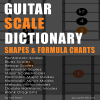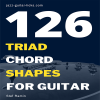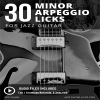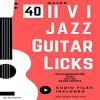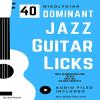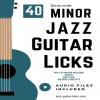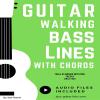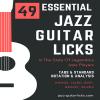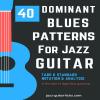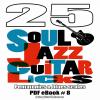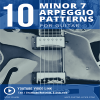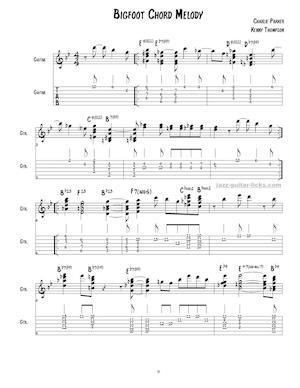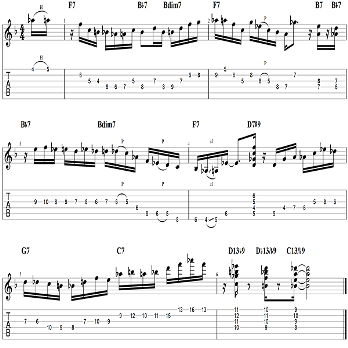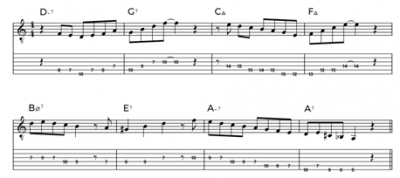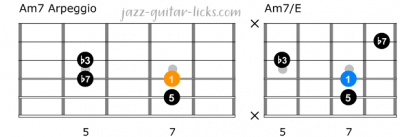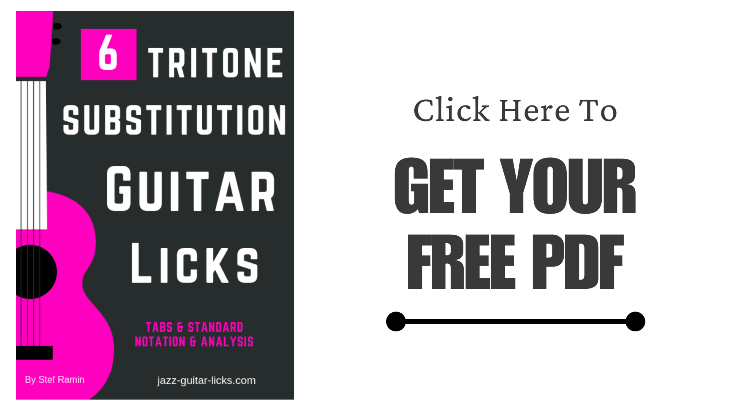
Jazz up Your Blues - Guitar Lesson
- By jazz-guitar-licks
- On 2018-09-22
- In Guest Posts
- 0 comments
 One of the most daunting shifts for any guitarist can be entering the world of jazz guitar. We’ve all read essential jazz guitar books, tutorials and watched videos by those in the know and it’s a vast world full of new theoretical and practical concepts.
One of the most daunting shifts for any guitarist can be entering the world of jazz guitar. We’ve all read essential jazz guitar books, tutorials and watched videos by those in the know and it’s a vast world full of new theoretical and practical concepts.
Most guitar players get into playing through rock/blues and find jazz later on their ability spectrum. If you understand blues, you can start to make some small changes which will add a jazz dynamic to your playing. In this lesson we will cover some of those small changes you can integrate into your playing today.
One of the first steps is to look at your typical blues progression and see what changes can be made to “jazz it up”. For the purpose of this lesson we will talk about everything in the key of A Minor but the rules are transposable to different keys.
Let’s assuming you’re playing your I IV V in A so that gives you A, D and E. For blues you can stick to those notes as they are commonly seen in blues as 5th or 7th chords, or we can go a little deeper and try some new voicings which would be more commonly found in jazz.
Let’s start by changing our A, D and E for an Amin7, D9 and E9:
Am7
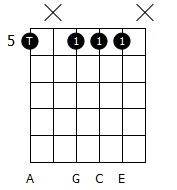
D9
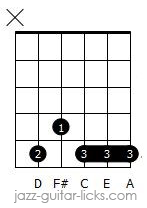
E9
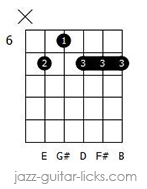
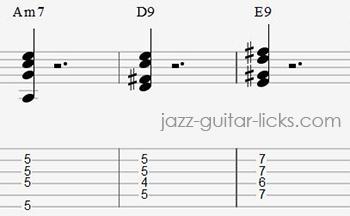
You can use these new chords to substitute the existing chords that you use in your 12 bar blues cycle. Notice for the Amin7 we are using our thumb to play the Low E string. This will come us use later on for some of the shifts and free up other fingers to play some of the walking parts.
Then you can take that a step further by adding some “walking bass” notes between the chords. The walking notes in this progression are all taken from the A Natural Minor Scale (Otherwise known as the Aeolian Mode). The notes being A, B, C, D, E, F, G and A. We only need the first octave for this.
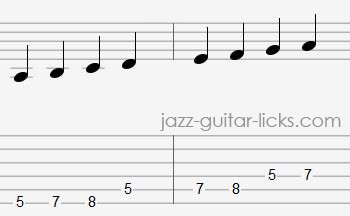
To give an example on the technique here, we are going to stick with a 4 bar loop following the I, IV, V, IV progression. That’s Amin7, D9, E9, D9. In between each chord change, we are going to add a walking note from the scale to “walk” one chord into the next:
Example 1:
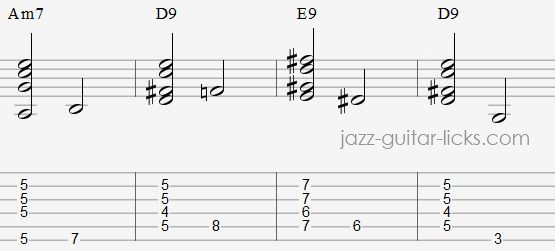
The only note here that isn’t in the scale is the D# (6th fret of the A string) which is the b5 of the Aeolian. The b5 is often added to the pentatonic scale as the “blues” note so will tie in perfectly with our objective here. In this example, the playing of the chord will cover the first 2 beats of the bar and the walking note will cover the remaining 2.
Example 2:
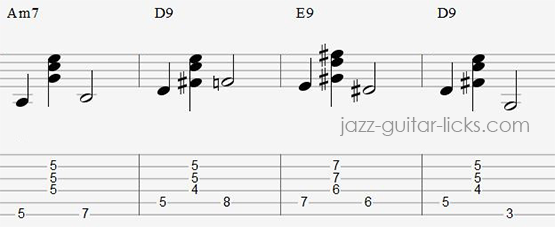
When you want to take it a step further you can split out the chord into a bass note and a chord triad. This will cover 2 beats with each segment of the chord being a quarter note long. The root note will be on the first beat and the chord triad on the second beat. The walking note will be 2 beats long.
Example 3:
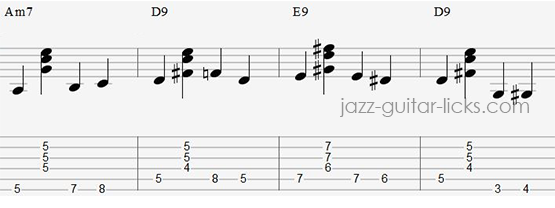
When combining chords and walking basslines, it takes time to build up your rhythmic awareness and create more complex lines. For this example we are going to take the previous example and add an extra walking note. Where we had the chord split into a bass note and a triad across the first 2 beats and the walking note covering the remaining 2, now we are going to add a second walking note.
Both walking notes will cover beats 3 and 4 respectively. The G# note on the 4th fret of the Low E is outside of the scale but the chromatic run of the G to G# before resolving on the root works well in this context.
Example 4:

Now that we’ve built up to playing chords and a walking bass line around a quarter note rhythm it’s time to add some swing. The chord is still split into a root note and a triad, but the timing has now been shifted to a dotted eighth note for the root and a sixteenth note for the triad.
We would count this bar as we always count bars of sixteenths (1 e & a) with the root note covering the “1 e &” and the triad hitting on the “a”. As we’ve condensed the chord to fit within one beat we now have three beats left in the bar. This means we can add three walking notes as quarter notes.
The additional walking notes added here are all chromatic notes between the existing walking notes from the previous example. The only change is the C note on the Low E string has been relocated to the 3rd fret of the A string for ease of movement on the chromatic run into the D9 chord. Break this one down and run over it slow to ensure the swing locks into the beat.
Lead Guitar:
I mentioned earlier that we were taking a blues in the key of A minor and adding a little jazz flavour. This means, if you want to improvise over one of these progressions, the A Minor pentatonic scale, or the A Aeolian Mode, would be the most relevant choice. You’d have your jazzy backing matching up with some bluesy licks from those scales.
Given the nature of this piece, we can also call upon the C Major Scale which will work in conjunction with the A Minor Pentatonic. C Major is the relative major of A Minor so you can use both scales at the same time will create some very interesting textures over a jazzy backdrop.
If sticking in the key of A Minor, keep a watch out for your b3 notes in the scale (That’s your C notes). You can play a b3 and bend it up half a step to a C# note as it would appear in the C Major scale. Bending between the b3 and the 3 intervals will create an interesting minor to major shift in your lead parts.
The rules in this lesson are transposable to any key so try this in different positions across the fretboard and enjoy the results.
About the Author
 Leigh Fuge is a professional guitarist, tutor and session musician from the UK. He has taught hundreds of guitar lessons to students and enabled them to explore their abilities. He is a blues enthusiast and is always seeking new ways to explore other genres of music via the medium of the blues. When he’s not teaching or writing about guitar, you can find him on the stage or hunting for more vintage gear.
Leigh Fuge is a professional guitarist, tutor and session musician from the UK. He has taught hundreds of guitar lessons to students and enabled them to explore their abilities. He is a blues enthusiast and is always seeking new ways to explore other genres of music via the medium of the blues. When he’s not teaching or writing about guitar, you can find him on the stage or hunting for more vintage gear.
-
Guitar Chord Dictionary
This PDF eBook provides over 550 guitar chord shapes. This is the perfect reference guide to understand how chords are built and how to play them on the guitar neck. -
Guitar Scale Dictionary
This E-book is a printable PDF method including over 700 scale diagrams and formula charts for guitarists. -
Harmonized Scales For Guitar
Complete guitar PDF on harmonized scales: major, minor, harmonic and melodic. Includes chord and arpeggio diagrams, charts and practical tabs. -
172 Arpeggio Shapes For Guitar
This printable PDF is a method dedicated to guitarists of all styles who want to learn build and play the most important types of arpeggios. -
126 Triad Chord Shapes
This handbook for guitar players is intended both for teachers and students. It includes 126 guitar shapes for mastering triads. -
Harmonic Major Scale Chords
this PDF offers diagrams and tabs for guitar to learn the chords of the harmonic major scale. -
Major Scale Harmonization
This package provides a printable PDF with exercises and audio files to learn how to harmonize the major scale with 3 note chords and their extensions. -
30 Minor Arpeggio Licks
This package includes a printable PDF method containing 30 exercises with tabs, staves and audio files for practicing minor arpeggios on guitar. -
II V I Bundle - 170 Exercises
This bundle contains 4 PDF methods for a total of 170 exercises with tabs, staves, analysis & audio files for practicing scales, arpeggios licks & chords over the 2-5-1 progression. -
Diatonic Licks Bundle
This package contains 120 jazz guitar lines based on diatonic modes as Mixolydian, Dorian and Ionian. PDF format with tabs, audio files and analysis. -
30 Groovy Jazz Guitar Licks
This downloadable package contains a PDF WITH audio files giving access to 30 groovy guitar phrases mixing jazz, blues and funky licks for beginners. -
30 Smooth Jazz Guitar Licks
In this package you'll get a printable PDF Method with tabs, notation, analysis, scale shapes and audio files for practicing 30 smooth jazz guitar licks. -
40 II V I Jazz Guitar Licks
This pdf method for guitar contains fourteen 2 5 1 jazz guitar lines with tab, standard notation, analysis, scale charts and audio files. -
50 II-V-I voicings
This printable PDF guitar method provides 50 exercises with audio files, analysis, tab and staves for learning major 2-5-1 chord voicings. -
40 Minor 2 5 1 Chord Voicings
This PDF method contains 40 exercices with tabs, scores and audio files for practicing jazz guitar chords over the minor 2 5 1 progression. -
40 Minor II V I Licks
This guitar method is a printable PDF with tabs, diagrams, theory and audio files providing 40 minor 2 5 1 jazz patterns. -
40 Mixolydian Jazz Guitar Lick
PDF guitar method with tabs, audio files and theory providing 40 dominant jazz guitar lines for teachers and students. -
40 Minor Jazz Guitar Licks
This printable guitar method in PDF format contains 40 easy minor jazz guitar lines based on the Dorian mode. -
40 Major Jazz Guitar Licks
Printable PDF eBook method containing 40 major jazz guitar licks with tab, standard notation and audio files for beginners and intermediates. -
Guitar Walking Bass Lines
This jazz guitar method about walking bass lines and chords is available as a PDF files containing 35 exercises with tabs, analysis and audio files -
101 Dominant Arpeggio Patterns
This printable PDF method provides 101 dominant arpeggio exercises with tab, theory and standard notation for the jazz, blues and rock guitarist. -
49 Essential Jazz Lines
This printable eBook method in PDF format provides 49 jazz solo transcriptions of the greatest jazz musicians. Tab, standard notation, audio files & analysis. -
11 Jazz Blues Studies
11 jazz blues chord studies with tabs, standard notation, analysis, and audio recordings and PDF. -
10 Easy Fingerstyle Blues
This PDF with Tabs and audio files provides 10 easy acoustic fingerstyle blues guitar studies for kids and beginners. -
25 Altered Jazz Guitar Lines
This PDF eBook method contains 25 altered jazz guitar licks with tabs, patterns, scale charts and audio files to master, apply and develop the altered scale. -
40 Blues Dominant Patterns
This printable method is available as a PDF file containing 40 easy dominant jazz-blues guitar lines with tabs, standard notation, analysis, audio files and scale charts. -
25 Pentatonic Licks
This jazz guitar method is an eBook available as a PDF with standard notation, guitar tabs, diagrams, analysis, audio files and backing tracks. You will find in this booklet 25 easy jazz guitar lines with theory using common and rare pentatonic scales. -
25 Soul Jazz Guitar Licks
You will find here an eBook available in PDF containing 25 soul jazz and hard bop guitar licks in the style of Grant Green, Melvin Sparks, George Benson. -
25 Diminished Patterns
This eBook PDF with audio files contains 25 dominant diminished jazz guitar patterns using the half-whole diminished scale and diminished 7th arpeggios. -
6 Tritone substitution licks
This Printable PDF eBook available for free download contains 6 easy jazz guitar licks with tabs/notation, youtube video link and analysis about the tritone substitution. -
10 Minor 7 Arpeggio Patterns
This printable PDF eBook offers 10 easy minor 7 arpeggio patterns with its related YouTube video for beginner guitarists. -
10 Easy Major 7 Arpeggio Licks
This is a printable PDF for beginner jazz guitar players providing 10 easy licks to practice major 7 arpeggios. -
10 Chord Melody Lines
Within this package, you'll discover a set of ten chord melody exercises for beginners. Printable PDFaudio files, a backing track, and a link to the associated YouTube video. -
10 Minor Blues Scale Licks
You'll find here a PDF with 10 easy jazz guitar licks to practice the minor blues scale on guitar.
jazz guitar guitar lesson Guest post Blues guitar
Add a comment

